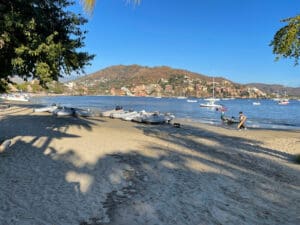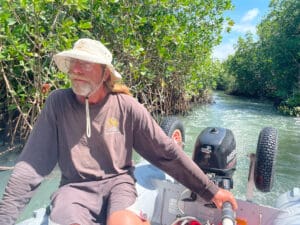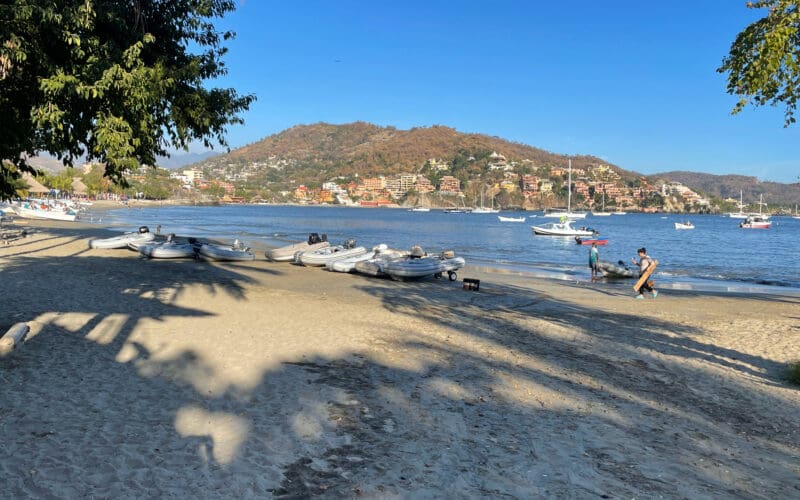 The ship’s dinghy is such a simple thing: a rubber tube, some floor boards, and a motor. What could possibly go wrong? During my six months in Pacific Mexico I got to find out.
The ship’s dinghy is such a simple thing: a rubber tube, some floor boards, and a motor. What could possibly go wrong? During my six months in Pacific Mexico I got to find out.
As an early indication of unexpected required maintenance — my girlfriend flew in to Mexico, I picked her up in the dinghy, we motored out to the open roadstead anchorage a mile and a half out and just feet from my 45-foot Morgan sloop Tiger Beetle the outboard died. In 18 knot winds and choppy water we started to drift offshore towards the Pacific Ocean. I pulled on the starter cord but the motor wasn’t having any of it. Mt girlfriend pointed out that Beetle was getting further away and anything needed to fix the outboard was on the boat, not the dinghy – how about rowing quickly to make up the rapidly expanding (but currently short) distance?
After we rowed back to the boat (and waved off a tow from a passing jet ski), I found that the fuel line connector to the motor had worn, allowing air into the fuel line and that caused it to die; time to replace the connector.
In Pacific Mexico most shore visits start with sand beach landing, after which the dinghy needs to be moved up the beach to clear the surf. Dragging a Hypalon rubber boat across sand is hard on the rubber so I had bolted large diameter flip-down wheels to the transom. With wheels supporting the weight of the outboard and dinghy, it’s relatively easy to roll the boat up the beach by myself.
A month later, following a run ashore to the local mercado , I went to launch the dinghy and one of the beach wheels burst an inner tube and the boat fell over to one side — at least the full load of groceries stayed in the dinghy and didn’t get wet. I eventually made it back to Beetle and fetched out the box containing my trusty spare inner tube. Unfortunately, the tube’s rubber was too old and had rotted. Now what? My first thought was to refill the tire with expanding spray foam, I had read about that; hopefully it would work well enough to get the boat up the beach. Now I keep foam on board instead of a spare inner tube. I read up on tire diameters. It turns out the beach wheels can be a match for wheelbarrow tires and there are wheelbarrows in rural Mexico. Conveniently the local ferreteria (hardware store) had replacement tires and inner tubes; I bought two of each and now the dinghy sports brand new heavily knobbed wheels.
 One might think that the dinghy would be happy for awhile with brand new wheels, but no such luck. I soon noticed that the motor wouldn’t run while in idle. I use a 9.9 HP four-stroke Mercury outboard for the trips in. This is a good, relatively quiet motor, but like any four-stroke outboard it can be finicky about getting clean gas. While gas can be found most places, it doesn’t always arrive in clean containers. I received some bad gas drawn from a reasonably rusty 55 gallon drum, resulting in the carburetor’s idle jet repeatedly plugging. Carb cleaner came to the rescue and I became unexpectedly proficient at removing the carburetor to clean the jets.
One might think that the dinghy would be happy for awhile with brand new wheels, but no such luck. I soon noticed that the motor wouldn’t run while in idle. I use a 9.9 HP four-stroke Mercury outboard for the trips in. This is a good, relatively quiet motor, but like any four-stroke outboard it can be finicky about getting clean gas. While gas can be found most places, it doesn’t always arrive in clean containers. I received some bad gas drawn from a reasonably rusty 55 gallon drum, resulting in the carburetor’s idle jet repeatedly plugging. Carb cleaner came to the rescue and I became unexpectedly proficient at removing the carburetor to clean the jets.
Dinghy problem solving was not over, though! The Achilles Hypalon dinghy is stowed belowdecks while sailing. When I reach the next anchorage I set it up again. During one of the foredeck dinghy assemblies a shifting floor board caught and tore the rubber end cap of the inflatable keel, creating a one-half-inch tear in the cap. When the keel is inflated it creates a V hull and raises the bow, which makes the dinghy quick and fairly dry; without the keel the hull is flat and the boat becomes slow and wet. Fortunately the dinghy still worked, just not so well.
The first repair failed immediately as the Hypalon fabric and glue I used over the hole didn’t adhere well to the rubber cap. I next created a makeshift spacer with four large diameter pool noodles found at a beach-front store; I deflated the dinghy, placed the pool noodles and a life jacket under the floor boards and re-inflated the dinghy to produce an oddly-shaped keel that lifted the bow — a much better ride in the dinghy, still not ideal.
I checked in with Sal’s Inflatables up north in California, and Sal said the best repair for that hole is to fill the inside of the cap with Sikaflex 291, let it cure, and you’re good to go — but I could only find 3M products in Mexico, no Sikaflex. I wanted a material roughly as flexible as the Sikaflex, and the 3M 5200 I keep on board was too hard. So I spent time reading up on the durometer/Shore A Hardness values for various products. I learned that 3M 4200 closely matches the Sikaflex values , is good for above and below waterline use, and a month later I found a store carrying 4200 in caulk tube sizes.
The repair is straightforward: clean out the end cap interior by running fresh water through the keel tube via the air fill port, then pump a lot of air through the keel tube to dry. Enlarge the hole to accept the tip of the caulking gun tube, calculate how far the plunger needs to go to ensure the cap is filled to above the hole (and not much further), then pump in the 4200, then let it sit for two days in the sun. The result has been a dinghy that continues working well.
My thoughts: when anchoring out and counting on the dinghy to get you to and from shore, consider the major failure points, acquire spares to keep onboard, obtain the information needed to diagnose and perform the repairs, and carry necessary tools. An example of a weird tool I needed for removing the carburetor on a Nissan/Mercury 9.9 outboard: an extra-long 10 inch socket drive extension to reach in behind the air filter to get at the inboard carburetor bolt. Without that extension, I could not find a way to undo that bolt. Fortunately, many outboards (less than 20 horsepower) are using a Tohatsu motor: Nissan, Mercury, and Tohatsu all have the same motor under the cowling and the spare parts I had from the old Nissan fit the newer Mercury.
As with every piece of gear on board, may the dinghy always cooperate!
Spares and parts that I carry:
Outboard motor repair/parts manual with exploded drawings, spark plugs, fuel filters, water pump impeller, motor oil, lower gear oil, propellors, a fuel tank gas line, squeeze bulb, and connector.
Dinghy patch material (including two large sheets), two-part glue, valves and valve caps, an extra oar, and a backup air pump.
Expanding foam for the beach wheels.
Rob MacFarlane has raced and cruised as a singlehander for 30 years on San Francisco Bay, the West Coast, Hawaii, Mexico, Canada and French Polynesia.

